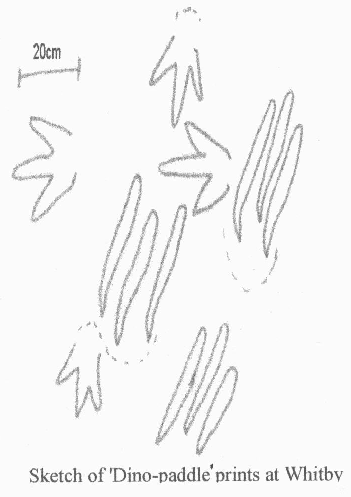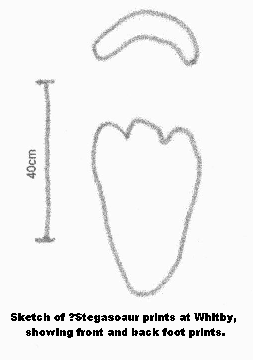
Three toed footprints from Burniston

Sketch of "Dino-paddle" prints, Whitby.

Sketch of prints at Whitby, now thought to be of a Stagasaur, showing front and back footprints.
Humberside Geologist No 12 Online
Yorksire's Jurassic Park
by Mike Horne
(updated version)
If you mention fossils or tell someone you are interested in geology, they usually immediately think of dinosaurs. Looking at the number of books, films and TV programmes about them, one would assume that they are the commonist form of ancient life! But in fact their remains are quite rare. In over 25 years of collecting I have never found any part of one. In fact the first ever complete skeleton of Tyrannosaurus rex. was only found a few years ago.
There are several reasons for this. The first is that dinosaurs lived on the land, and most rocks are formed under the sea! Secondly the big creatures at the top of the food chain are less common than the tiny creatures and plants at the bottom. Also, as a general rule of thumb, the bigger the bone or shell is, the lower the chance of it being buried and fossilised.
But if you think about it, a big mobile creature is going to create a lot of footprints in its lifetime, and because it leaves more footprints than bones, there is a greater chance of these becoming fossilised. Unfortunately we cannot say which species of dinosaur made each type of print, the only way to be absolutely sure is if the creature died at the end of its walk and its bones were preserved at that spot; a highly unlikely event!
A lot of these footptints are preserved as natural casts. In other words the dinosaur walked over the mud at the edge of a river, leaving a footprint, and then a layer of sand was deposited over the mud, filling the footprint. Millions of years later , the mudrock is eroded away leaving the cast in a sandstone.
Sometimes you have to use a little bit of imagination when looking at these trace fossils. But they are really very common on our coastline between Scarborough and Whitby. There are even some markings that have been interpreted as swimming tracks of a dinosaur. The animal must have been doing the doggy paddle (or should that be "dino-paddle"?) in a shallow river, and its claws scratched the sediment on the river bottom.

Three toed footprints from Burniston

Sketch of "Dino-paddle" prints, Whitby.

Sketch of prints at Whitby, now thought to be of a Stagasaur, showing front and back footprints.
(c) Hull Geological Society 1999 + 2001
Back to Issue
12 index
Previous
page
Back to Humberside Geologist Online
Link to Mike's web-site.